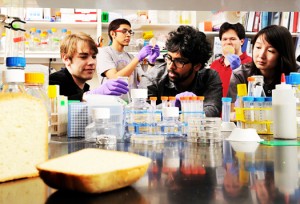Brands
How Futurity Turns University Discoveries into Shareable Content
Research today is the backbone for a significant portion of Internet content. Regardless of a blog’s model or standard — health breakthroughs, for example, fuel everything from high quality social commentary like Mark Bittman’s to content machines like Fit Sugar— they need new findings to keep their content current, and to root their post in some sort of reality.

Students at Johns Hopkins University developing a genetically engineered yeast that adds vitamin A to loaves of bread, and delivers extra nutrients.
But for Jenny Leonard, research is much more than a reference point — it is content worth sharing and exploring. Leonard is the editor behind Futurity, a website that reveals the latest discoveries coming out of university research departments.
“Universities produce a lot,” she explains, “and my team says here’s the stuff that matters, here’s what you should know.”
How Futurity Works
Futurity’s model runs deeper than exposing people to what’s happening idea-wise. Its strategy is really a hybrid of journalism and PR — an efficient way for universities to leverage the intrigue of their new ideas to ever widening audiences.
“The idea was that universities were already producing great content, but the role of press release was changing,” says Leonard. “On one hand there was this explosion of new channels for distribution — through the Internet — and yet there was a shrinking demand in more traditional outlets. Publications like Time and Newsweek were covering less and less research as news, often limiting them to news briefs or cutting them entirely.”
To solve this, universities came together with a goal to collect all of this content, to filter for the most digestible and appealing stuff, and to create a portal for this information. Sounds like a smart idea. But like most untested new strategies, Leonard’s team got some flack.
“When we first launched, there was a lot of push-back surrounding the idea that we were trying to replace science journalism,” she notes, “but in reality we don’t see ourselves that way at all.”
Their Strategy
The main difference, she reveals, lies in the content’s purpose. “The role of science journalists is to give context and “bigger picture” stuff, and we strictly stay away from that tone. What we is digestible, informative, and more mainstream.”
Leonard and the Futurity team receive tons of releases and clean them up so that they are fit for Internet virality. But to cap the site’s uniqueness at “digestible” would be a waste; its content is unlike any other research journal, school website or newspaper.
Here’s why, in Leonard’s own words:
- “We are extremely picky with our story topics. They have to be very interesting or unusual, and more human interest-y. We are lucky in that a lot of content comes our way, but it means we need to be that much more selective.”
- “We maintain credibility. We try to make it clear that universities are funding this project, and that they are generally trusted entities so the information is ‘good.’ To do this, we include the university name in every story’s dateline, and make sure that the first reference to the research always links back.”
- “We always keep headlines really short. It’s an effective way to get your message spread across easily. Google loves it, Twitter loves it — it just tends to work for us.”
- “We never stop paying attention to compelling artwork and visuals. It’s become our trademark. It sounds so simple, but I don’t know if everybody puts in the effort. It tells the research’s story in a slightly different way almost immediately.”
Their Secret – An Editing Eye
Of course, an inherent part of the site’s strategy revolves around selectivity with its university partners.
“We originally started with around 30 pretty elite members of the AAU 62, which is a group of the most research intensive universities,” she notes.
But though Futurity has since added most of the American group, a similar group in the UK, eight schools in Australia, and are slated for a few in Europe and Asia, Leonard never rushes in to a deal. “Our team is very streamlined and effective with a small staff, so to keep the flow of content manageable we have to be selective about opening memberships.”
Futurity has taken risks, and as a result changed the relationship between research, universities and web consumers. The coolest unexpected result of this so far? The direct interactions that occur on-site, Leonard says.
“Futurity offers readers direct access to contact with the actual researchers. We’ve had plenty directly respond to questions, comments, and that’s pretty unique for something as isolated as university research.”
“Being the catalyst for that conversation is pretty neat,” she notes. Understandably, we agree.
Related articles
- Is Futurity the Future? (cjr.com)
- How TED Uses Content To Spread Incredible Ideas (contently.com)
- How Much Content Is On The Web? (contently.com)
- 10 Ways Universities Share Information Using Social Media (mashable.com)
Get better at your job right now.
Read our monthly newsletter to master content marketing. It’s made for marketers, creators, and everyone in between.






